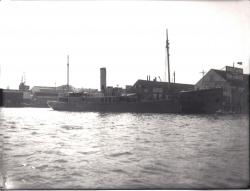Created by Lyman Moore Middle School students
The state of Maine's largest port is Portland. Portland has proximity to some of the best fishing in the Atlantic Ocean. Many settlers in the 1800's turned to fishing for their livelihood. Fishing in Portland changed over the next couple of centuries.
There are different kinds of fish in the bay than in the ocean. This has led to the development of different methods of catching fish. Examples of saltwater fish are pollack, herring, haddock, mackeral, cod, and flounder. Fishing methods have changed from winchheads to 14-inch hydroslave hoists. Fishing boats have improved from wood and metal to fiberglass which lasts longer. Also engines have changed from gasoline to diesel fuel.
Over the years, the Portland waterfront has changed into a highly populated area with many wharves and a growing fishing industry.
In the old days of fishing, people would anchor their boats in the harbor and row their catch to shore. If it was a bigger boat it would go to a dock and unload there.
Commercial fishermen are often at sea for up to two weeks. When they return to the harbor, they take their catch to the Portland Fish Exchange where it is sold at an auction. The length of the trip depends in part on what they are fishing for, how far they go out, and fishing regulations.
Workers process fish into barrels so they can be sent to different states or countries. This photograph was taken in Eastport, Maine but there were similar operations along Portland's waterfront. With new technology fish are auctioned and trucked to the merchants for sale.
Boats docked near fishing shops in order to sell their catch. Fishermen got a lot of money from selling their catch depending on its weight. Today bigger boats catch about 300 thousand pounds each trip and the industry makes around 1 million dollars a year depending on how long the boats go out to sea.
As the fishing industry became mechanized, large trawlers would sweep the ocean floors with nets.
Today fishermen use ice on the boats to keep their catch fresh. In the old days, fish would have been preserved by drying or salting them.
In the year 2003 the Portland Fish Exchange handled 21 million pounds of fish at 2 million pounds a month. The amount of fish handled differs in the seasons. For example, the Portland Fish Exchange handled 5 million pounds of hake in 2003.
We would like to thank the following people for helping us with this project:
Steve Bromage
Phoebe Tureen
Rob Inman
Jeff Monroe
Ray St. Pierre
Thank you again for helping us you were a great help.










